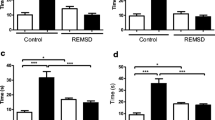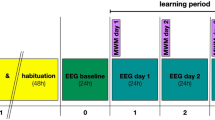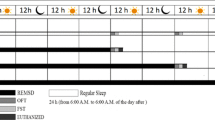Abstract
There is compelling evidence that sleep deprivation (SD) is an effective strategy in promoting antidepressant effects in humans, whereas few studies were performed in relevant animal models of depression. Acute administration of antidepressants in humans and rats generates a quite similar effect, i.e., suppression of rapid eye movement (REM) sleep. Then, we decided to investigate the neurochemical alterations generated by a protocol of rapid eye movement sleep deprivation (REMSD) in the notably known animal model of depression induced by the bilateral olfactory bulbectomy (OBX). REMSD triggered antidepressant mechanisms such as the increment of brain-derived neurotrophic factor (BDNF) levels, within the substantia nigra pars compacta (SNpc), which were strongly correlated to the swimming time (r = 0.83; P < 0.0001) and hippocampal serotonin (5-HT) content (r = 0.66; P = 0.004). Moreover, there was a strong correlation between swimming time and hippocampal 5-HT levels (r = 0.70; P = 0.003), strengthen the notion of an antidepressant effect associated to REMSD in the OBX rats. In addition, REMSD robustly attenuated the hippocampal 5-HT deficiency produced by the OBX procedure. Regarding the rebound (REB) period, we observed the occurrence of a sustained antidepressant effect, indicated mainly by the swimming and climbing times which could be explained by the maintenance of the increased nigral BDNF expression. Hence, hippocampal 5-HT levels remained enhanced in the OBX group after this period. We suggested that the neurochemical complexity inflicted by the OBX model, counteracted by REMSD, is directly correlated to the nigral BDNF expression and hippocampal 5-HT levels. The present findings provide new information regarding the antidepressant mechanisms triggered by REMSD.





Similar content being viewed by others
References
Schulte W (1966) Kombinierte Psycho- und Pharmakotherapie bei Melancholikern. Probleme der pharmakopsychiatrischen Kombinations- und Langzeitbehandlung. Karger
Gorgulu Y, Caliyurt O (2009) Rapid antidepressant effects of sleep deprivation therapy correlates with serum BDNF changes in major depression. Brain Res Bull 80(3):158–162
Landsness EC, Goldstein MR, Peterson MJ, Tononi G, Benca RM (2011) Antidepressant effects of selective slow wave sleep deprivation in major depression: a high-density EEG investigation. J Psychiatr Res 45(8):1019–1026. doi:10.1016/j.jpsychires.2011.02.003
Kreuzer PM, Langguth B, Schecklmann M, Eichhammer P, Hajak G, Landgrebe M (2012) Can repetitive transcranial magnetic stimulation prolong the antidepressant effects of sleep deprivation? Brain Stimul 5(2):141–147. doi:10.1016/j.brs.2011.02.005
Giedke H, Schwarzler F (2002) Therapeutic use of sleep deprivation in depression. Sleep Med Rev 6(5):361–377
Palagini L, Baglioni C, Ciapparelli A, Gemignani A, Riemann D (2013) REM sleep dysregulation in depression: state of the art. Sleep Med Rev 17(5):377–390. doi:10.1016/j.smrv.2012.11.001
Zant JC, Leenaars CH, Kostin A, Van Someren EJ, Porkka-Heiskanen T (2011) Increases in extracellular serotonin and dopamine metabolite levels in the basal forebrain during sleep deprivation. Brain Res 1399:40–48. doi:10.1016/j.brainres.2011.05.008
Meyers N, Fromm S, Luckenbaugh DA, Drevets WC, Hasler G (2011) Neural correlates of sleepiness induced by catecholamine depletion. Psychiatry Res 194(1):73–78. doi:10.1016/j.pscychresns.2011.06.015
Sei H, Saitoh D, Yamamoto K, Morita K, Morita Y (2000) Differential effect of short-term REM sleep deprivation on NGF and BDNF protein levels in the rat brain. Brain Res 877(2):387–390
Wang YQ, Tu ZC, Xu XY, Li R, Qu WM, Urade Y, Huang ZL (2012) Acute administration of fluoxetine normalizes rapid eye movement sleep abnormality, but not depressive behaviors in olfactory bulbectomized rats. J Neurochem 120(2):314–324. doi:10.1111/j.1471-4159.2011.07558.x
Vogel GW (1983) Evidence for REM sleep deprivation as the mechanism of action of antidepressant drugs. Prog Neuropsychopharmacol Biol Psychiatry 7(2–3):343–349
Giedke H, Geilenkirchen R, Hauser M (1992) The timing of partial sleep deprivation in depression. J Affect Disord 25(2):117–128
Adrien J (2002) Neurobiological bases for the relation between sleep and depression. Sleep Med Rev 6(5):341–351
Asikainen M, Toppila J, Alanko L, Ward DJ, Stenberg D, Porkka-Heiskanen T (1997) Sleep deprivation increases brain serotonin turnover in the rat. Neuroreport 8(7):1577–1582
Lima MMS, Andersen ML, Reksidler AB, Ferraz AC, Vital AM, Tufik S (2012) Paradoxical sleep deprivation modulates tyrosine hydroxylase expression in the nigrostriatal pathway and attenuates motor deficits induced by dopaminergic depletion. CNS Neurol Disord Drug Targets 11:359–368
Lima MM, Andersen ML, Reksidler AB, Silva A, Zager A, Zanata SM, Vital MA, Tufik S (2008) Blockage of dopaminergic D(2) receptors produces decrease of REM but not of slow wave sleep in rats after REM sleep deprivation. Behav Brain Res 188(2):406–411. doi:10.1016/j.bbr.2007.11.025
Proenca MB, Dombrowski PA, Da Cunha C, Fischer L, Ferraz AC, Lima MM (2014) Dopaminergic D2 receptor is a key player in the substantia nigra pars compacta neuronal activation mediated by REM sleep deprivation. Neuropharmacology 76 Pt A:118–126. doi:10.1016/j.neuropharm.2013.08.024
Guzman-Marin R, Alam MN, Szymusiak R, Drucker-Colin R, Gong H, McGinty D (2000) Discharge modulation of rat dorsal raphe neurons during sleep and waking: effects of preoptic/basal forebrain warming. Brain Res 875(1–2):23–34
Tissier MH, Lainey E, Fattaccini CM, Hamon M, Adrien J (1993) Effects of ipsapirone, a 5-HT1A agonist, on sleep/wakefulness cycles: probable post-synaptic action. J Sleep Res 2(2):103–109
Vogel GW, Buffenstein A, Minter K, Hennessey A (1990) Drug effects on REM sleep and on endogenous depression. Neurosci Biobehav Rev 14(1):49–63
van Riezen H, Leonard BE (1990) Effects of psychotropic drugs on the behavior and neurochemistry of olfactory bulbectomized rats. Pharmacol Ther 47(1):21–34
Cairncross KD, Cox B, Forster C, Wren AF (1977) The olfactory bulbectomized rat: a simple model for detecting drugs with antidepressant potential [proceedings]. Br J Pharmacol 61(3):497P
Machado RB, Hipolide DC, Benedito-Silva AA, Tufik S (2004) Sleep deprivation induced by the modified multiple platform technique: quantification of sleep loss and recovery. Brain Res 1004(1–2):45–51
Broadhurst PL (1960) Experiments in psychogenetics. In: Einsenk HJ (ed) Experiments in personality. Routledge and Kegan Paul, London, pp 52–71
Porsolt RD, Anton G, Blavet N, Jalfre M (1978) Behavioural despair in rats: a new model sensitive to antidepressant treatments. Eur J Pharmacol 47(4):379–391
Reneric JP, Bouvard M, Stinus L (2002) In the rat forced swimming test, chronic but not subacute administration of dual 5-HT/NA antidepressant treatments may produce greater effects than selective drugs. Behav Brain Res 136(2):521–532
Elfving B, Plougmann PH, Wegener G (2010) Detection of brain-derived neurotrophic factor (BDNF) in rat blood and brain preparations using ELISA: pitfalls and solutions. J Neurosci Methods 187(1):73–77. doi:10.1016/j.jneumeth.2009.12.017
Bertaina-Anglade V, La Rochelle CD, Scheller DK (2006) Antidepressant properties of rotigotine in experimental models of depression. Eur J Pharmacol 548(1–3):106–114. doi:10.1016/j.ejphar.2006.07.022
Artaiz I, Zazpe A, Innerarity A, Del Olmo E, Diaz A, Ruiz-Ortega JA, Castro E, Pena R, Labeaga L, Pazos A, Orjales A (2005) Preclinical pharmacology of F-98214-TA, a novel potent serotonin and norepinephrine uptake inhibitor with antidepressant and anxiolytic properties. Psychopharmacology (Berlin) 182(3):400–413. doi:10.1007/s00213-005-0087-3
Breuer ME, Groenink L, Oosting RS, Buerger E, Korte M, Ferger B, Olivier B (2009) Antidepressant effects of pramipexole, a dopamine D3/D2 receptor agonist, and 7-OH-DPAT, a dopamine D3 receptor agonist, in olfactory bulbectomized rats. Eur J Pharmacol 616(1–3):134–140. doi:10.1016/j.ejphar.2009.06.029
Breuer ME, Groenink L, Oosting RS, Westenberg HG, Olivier B (2007) Long-term behavioral changes after cessation of chronic antidepressant treatment in olfactory bulbectomized rats. Biol Psychiatry 61(8):990–995. doi:10.1016/j.biopsych.2006.08.032
Sowa-Kucma M, Legutko B, Szewczyk B, Novak K, Znojek P, Poleszak E, Papp M, Pilc A, Nowak G (2008) Antidepressant-like activity of zinc: further behavioral and molecular evidence. J Neural Transm 115(12):1621–1628. doi:10.1007/s00702-008-0115-7
Hendriksen H, Meulendijks D, Douma TN, Bink DI, Breuer ME, Westphal KG, Olivier B, Oosting RS (2012) Environmental enrichment has antidepressant-like action without improving learning and memory deficits in olfactory bulbectomized rats. Neuropharmacology 62(1):270–277. doi:10.1016/j.neuropharm.2011.07.018
Pudell C, Vicente BA, Delattre AM, Carabelli B, Mori MA, Suchecki D, Machado RB, Zanata SM, Visentainer JV, de Oliveira Santos OJ, Lima MM, Ferraz AC (2013) Fish oil improves anxiety-like, depressive-like and cognitive behaviors in olfactory bulbectomised rats. Eur J Neurosci. doi:10.1111/ejn.12406
Seroogy KB, Lundgren KH, Tran TM, Guthrie KM, Isackson PJ, Gall CM (1994) Dopaminergic neurons in rat ventral midbrain express brain-derived neurotrophic factor and neurotrophin-3 mRNAs. J Comp Neurol 342(3):321–334. doi:10.1002/cne.903420302
Pierce RC, Bari AA (2001) The role of neurotrophic factors in psychostimulant-induced behavioral and neuronal plasticity. Rev Neurosci 12(2):95–110
Sokoloff P, Guillin O, Diaz J, Carroll P, Griffon N (2002) Brain-derived neurotrophic factor controls dopamine D3 receptor expression: implications for neurodevelopmental psychiatric disorders. Neurotox Res 4(7–8):671–678. doi:10.1080/1029842021000045499
Sokoloff P, Giros B, Martres MP, Bouthenet ML, Schwartz JC (1990) Molecular cloning and characterization of a novel dopamine receptor (D3) as a target for neuroleptics. Nature 347(6289):146–151. doi:10.1038/347146a0
Corrigan MH, Denahan AQ, Wright CE, Ragual RJ, Evans DL (2000) Comparison of pramipexole, fluoxetine, and placebo in patients with major depression. Depress Anxiety 11(2):58–65. doi:10.1002/(SICI)1520-6394(2000)11:2<58::AID-DA2>3.0.CO;2-H
Zarate CA Jr, Payne JL, Singh J, Quiroz JA, Luckenbaugh DA, Denicoff KD, Charney DS, Manji HK (2004) Pramipexole for bipolar II depression: a placebo-controlled proof of concept study. Biol Psychiatry 56(1):54–60. doi:10.1016/j.biopsych.2004.03.013
Song C, Leonard BE (2005) The olfactory bulbectomised rat as a model of depression. Neurosci Biobehav Rev 29(4–5):627–647. doi:10.1016/j.neubiorev.2005.03.010
Uchida N, Mainen ZF (2003) Speed and accuracy of olfactory discrimination in the rat. Nat Neurosci 6(11):1224–1229. doi:10.1038/nn1142
Soh Z, Saito M, Kurita Y, Takiguchi N, Ohtake H, Tsuji T (2014) A comparison between the human sense of smell and neural activity in the olfactory bulb of rats. Chem Senses 39(2):91–105. doi:10.1093/chemse/bjt057
Ebrahim IO, Peacock KW (2005) REM sleep behavior disorder–psychiatric presentations: a case series from the United Kingdom. J Clin Sleep Med 1(1):43–47
Wirz-Justice A, Van den Hoofdakker RH (1999) Sleep deprivation in depression: what do we know, where do we go? Biol Psychiatry 46(4):445–453
Southmayd SE, David MM, Cairns J, Delva NJ, Letemendia FJ, Waldron JJ (1990) Sleep deprivation in depression: pattern of relapse and characteristics of preceding sleep. Biol Psychiatry 28(11):979–988
Mineur YS, Obayemi A, Wigestrand MB, Fote GM, Calarco CA, Li AM, Picciotto MR (2013) Cholinergic signaling in the hippocampus regulates social stress resilience and anxiety- and depression-like behavior. Proc Natl Acad Sci U S A 110(9):3573–3578. doi:10.1073/pnas.1219731110
Gillin JC, Sutton L, Ruiz C, Kelsoe J, Dupont RM, Darko D, Risch SC, Golshan S, Janowsky D (1991) The cholinergic rapid eye movement induction test with arecoline in depression. Arch Gen Psychiatry 48(3):264–270
Basheer R, Magner M, McCarley RW, Shiromani PJ (1998) REM sleep deprivation increases the levels of tyrosine hydroxylase and norepinephrine transporter mRNA in the locus coeruleus. Brain Res Mol Brain Res 57(2):235–240
Shores MM, Szot P, Veith RC (1994) Desipramine-induced increase in norepinephrine transporter mRNA is not mediated via alpha 2 receptors. Brain Res Mol Brain Res 27(2):337–341
Fujihara H, Sei H, Morita Y, Ueta Y, Morita K (2003) Short-term sleep disturbance enhances brain-derived neurotrophic factor gene expression in rat hippocampus by acting as internal stressor. J Mol Neurosci 21(3):223–232
Duncan WC, Sarasso S, Ferrarelli F, Selter J, Riedner BA, Hejazi NS, Yuan P, Brutsche N, Manji HK, Tononi G, Zarate CA (2013) Concomitant BDNF and sleep slow wave changes indicate ketamine-induced plasticity in major depressive disorder. Int J Neuropsychopharmacol 16(2):301–311. doi:10.1017/S1461145712000545
Schrag A (2004) Psychiatric aspects of Parkinson’s disease—an update. J Neurol 251(7):795–804
Dremencov E, Newman ME, Kinor N, Blatman-Jan G, Schindler CJ, Overstreet DH, Yadid G (2005) Hyperfunctionality of serotonin-2C receptor-mediated inhibition of accumbal dopamine release in an animal model of depression is reversed by antidepressant treatment. Neuropharmacology 48(1):34–42
Blandini F, Nappi G, Tassorelli C, Martignoni E (2000) Functional changes of the basal ganglia circuitry in Parkinson’s disease. Prog Neurobiol 62(1):63–88
Nestler EJ, Barrot M, DiLeone RJ, Eisch AJ, Gold SJ, Monteggia LM (2002) Neurobiology of depression. Neuron 34(1):13–25
Acknowledgements
This paper was supported by CAPES and the Conselho Nacional de Desenvolvimento Científico e Tecnológico—CNPq—Brasil Grants Casadinho/Procad no. 552226/2011-4 and Universal no. 473861/2012-7 to MMSL. MMSL, SMZ, and CDC are recipients of CNPq fellowship. The authors wish to express their sincere gratitude to Prof. Dr. Roberto Andreatini from Pharmacology Department of UFPR for the technical assistance.
Conflict of Interest
The authors have declared that no conflict of interests exists.
Author information
Authors and Affiliations
Corresponding author
Rights and permissions
About this article
Cite this article
Maturana, M.J., Pudell, C., Targa, A.D.S. et al. REM Sleep Deprivation Reverses Neurochemical and Other Depressive-Like Alterations Induced by Olfactory Bulbectomy. Mol Neurobiol 51, 349–360 (2015). https://doi.org/10.1007/s12035-014-8721-x
Received:
Accepted:
Published:
Issue Date:
DOI: https://doi.org/10.1007/s12035-014-8721-x




